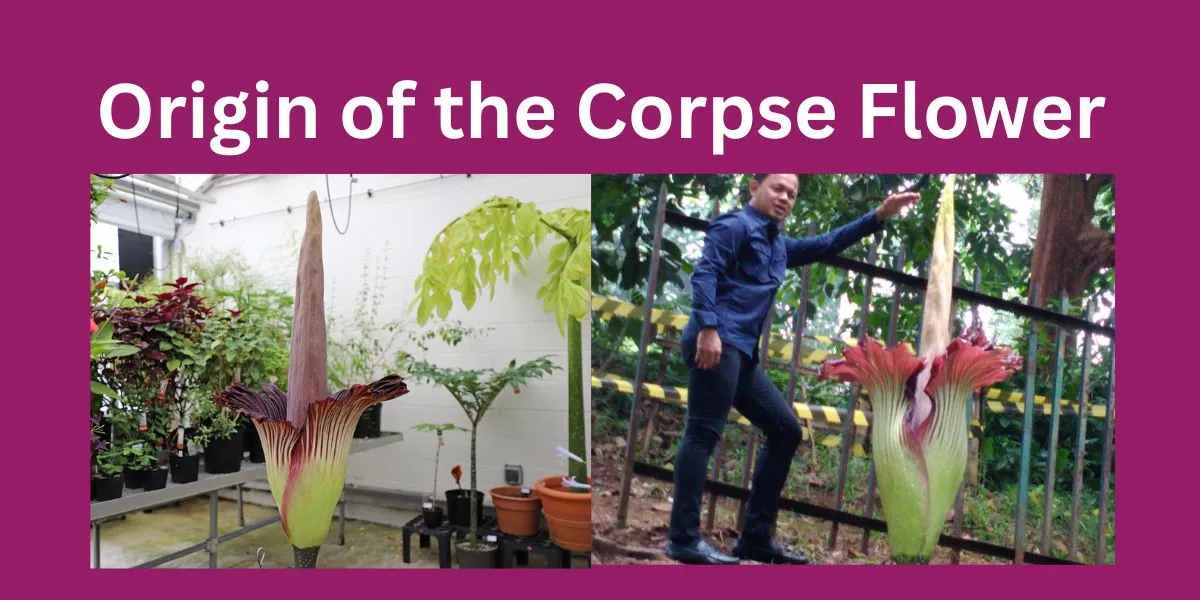Have you ever heard of a flower that smells like rotting flesh? Strange, right? Welcome to the world of the corpse flower! Officially known as Amorphophallus titanum, this unique plant stands out for its massive size, rare blooming, and unforgettable smell. In this article, we’ll dive deep into the origins of the corpse flower, how it came to be, and why it’s such a rare spectacle in nature.
What is the Corpse Flower?
The corpse flower, also called the Titan arum, is a giant flowering plant native to the rainforests of Sumatra, Indonesia. Its scientific name, Amorphophallus titanum, roughly translates to “giant misshapen phallus,” a nod to its towering, unusual structure. What really captures attention is its overwhelming scent, often compared to that of a decaying animal.
Origins of the Corpse Flower
A Native of Indonesia’s Sumatra Rainforest
The corpse flower is indigenous to the lush rainforests of Sumatra, one of Indonesia’s largest islands. Sumatra’s humid, tropical climate provides the perfect conditions for this plant to thrive. Its origins trace back millions of years, evolving alongside other unique flora and fauna found in this isolated island ecosystem.
A Plant Shrouded in Mystique
First documented in 1878 by Italian botanist Odoardo Beccari, the corpse flower quickly became a sensation due to its bizarre appearance and scent. Beccari was astonished to find a plant that not only reached such a staggering height but also emitted such a pungent odor. His discovery was significant, bringing global attention to Sumatra’s rich biodiversity.
Why Does It Smell So Bad?
Now, you might be wondering, why would a flower want to smell like something that died? The answer lies in its pollination strategy.
Mimicking Rotting Flesh to Attract Pollinators
The corpse flower’s foul odor serves a purpose: attracting pollinators. Unlike roses or lilies that attract bees, the corpse flower attracts insects that are drawn to the smell of rotting meat, such as flies and carrion beetles. These bugs play a critical role in pollinating the plant, helping it reproduce.
A Smelly Success
By releasing chemicals like putrescine and cadaverine, the corpse flower mimics the stench of decay, tricking insects into thinking they’ve found food. As they move from flower to flower, these pollinators unknowingly spread pollen, ensuring the survival of the species.
Anatomy of the Corpse Flower
The corpse flower has a complex structure that’s unlike most other flowering plants.
The Tallest Bloom in the World
Reaching heights of 8 to 10 feet, the corpse flower is one of the largest and tallest blooming plants in existence. The flower consists of a central spike called a spadix, which is surrounded by a frilly petal-like structure called the spathe.
The Lifecycle of a Giant
The corpse flower goes through a remarkable transformation as it matures. After years of growth underground as a large tuber, it finally blooms. But the flower’s life above ground is short-lived. It blooms for just 24 to 48 hours before it begins to wither, leaving onlookers in awe of this brief yet spectacular event.
The Rare Blooming Cycle of the Corpse Flower
Unlike most flowers that bloom seasonally, the corpse flower’s blooming cycle is highly irregular.
Years of Patience for a Few Days of Bloom
A corpse flower can take 7 to 10 years to bloom for the first time, with subsequent blooms occurring every 3 to 10 years. Due to the lengthy dormancy and growth period, spotting a corpse flower in bloom is a rare and special experience.
Blooming Events Worldwide
Botanical gardens and conservatories around the world cultivate corpse flowers, hoping for the rare occasion when one blooms. When it does, these gardens attract thousands of visitors eager to witness the rare and curious event.
Why Is the Corpse Flower So Rare?
Special Conditions Required for Growth
The corpse flower is sensitive to its environment, requiring very specific conditions to thrive. Native to a rainforest, it needs high humidity, warm temperatures, and rich soil. These factors make it challenging to grow the corpse flower outside its natural habitat.
Conservation Efforts and Botanical Gardens
Because of habitat destruction in Sumatra, conservationists work tirelessly to preserve the corpse flower in botanical gardens worldwide. These efforts not only allow people to witness this unique bloom but also help protect the species from extinction.
How Do Corpse Flowers Grow?
The Role of the Tuber
The life of a corpse flower begins with a tuber, an underground stem that stores nutrients. This tuber can weigh as much as 200 pounds! As it grows, it provides the necessary energy for the plant’s colossal bloom.
The Importance of Careful Cultivation
Botanists carefully monitor the growth of corpse flowers in captivity. They provide the ideal balance of moisture, temperature, and light to mimic its native environment, maximizing the chances of a successful bloom.
The Corpse Flower’s Role in Ecosystems
In its natural habitat, the corpse flower plays a unique role in the rainforest ecosystem.
Supporting Decomposers
By attracting flies and beetles, the corpse flower indirectly supports the decomposer population. These insects also help break down dead plants and animals, contributing to the forest’s nutrient cycle.
A Rare Source of Nutrients for Pollinators
The corpse flower’s putrid smell provides a feeding and breeding ground for certain insect species, creating an odd yet essential balance in its ecosystem.
Cultural Significance of the Corpse Flower
Beyond its biological interest, the corpse flower has become a symbol of intrigue and wonder.
A Symbol of Patience and Rarity
Due to its rare and unpredictable blooming cycle, the corpse flower is often viewed as a symbol of patience and rarity. In some cultures, witnessing a bloom is considered a once-in-a-lifetime event.
Popularity in Media and Pop Culture
The corpse flower’s unique characteristics have captured global fascination, appearing in documentaries, books, and TV shows. Its rarity and strangeness make it a popular subject for nature enthusiasts and the general public alike.
Fun Facts About the Corpse Flower
- Largest Flowering Structure: The corpse flower is not technically a single flower but a cluster of tiny flowers, making it one of the largest flowering structures in the world.
- A Once-in-a-Blue-Moon Event: Some corpse flowers have gone decades without blooming, while others bloom every few years.
- Temperature Control: The spadix generates heat, further enhancing the smell and attracting more pollinators.
- Different Smells: While the rotting smell is most famous, some people report hints of cheese or garlic!
Witnessing a Bloom in Person
If you’re lucky enough to live near a botanical garden with a corpse flower, check their schedules to see if they anticipate a bloom. Many gardens will livestream the event, giving people around the world a front-row seat to this rare natural wonder.
Conservation and the Future of the Corpse Flower
Habitat loss in Sumatra poses a major threat to the corpse flower. Conservationists continue to work on preserving not only this plant but the ecosystem it calls home. Through botanical gardens and educational programs, the world remains captivated by the corpse flower, and efforts to protect it grow stronger every year.
Conclusion
The corpse flower is truly a marvel of nature – a rare and awe-inspiring plant with an unforgettable smell and a towering bloom. Its origins in the rainforests of Sumatra highlight the incredible diversity of our planet, and its presence in botanical gardens around the world reminds us of the importance of conservation. If you ever get the chance to witness a corpse flower in bloom, don’t miss it. It’s a stinky, once-in-a-lifetime experience worth every second!
FAQs
Q1: Why is the corpse flower so rare?
A: The corpse flower is rare because it requires very specific growing conditions and can take years to bloom, even under perfect circumstances.
Q2: Can the corpse flower be grown at home?
A: Growing a corpse flower at home would be extremely challenging due to its size, environmental needs, and the long blooming cycle.
Q3: How tall can a corpse flower grow?
A: Corpse flowers can grow up to 10 feet tall, making them one of the largest flowers in the world.
Q4: Why does the corpse flower smell so bad?
A: The smell attracts specific pollinators, like flies and beetles, that are drawn to the scent of decaying flesh.
Q5: Where can I see a corpse flower bloom?
A: Many botanical gardens cultivate corpse flowers and host viewings during blooming events. Check with local conservatories or watch online livestreams.










